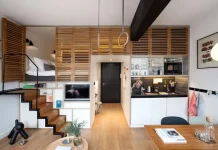Metal is a material commonly used in bridges, processing plants, and other structures because of its natural strength, flexibility, and mass manufacturing access. Metal is becoming more prevalent as a design element nowadays. Metal gives engineers, architects, and other building professionals both creative freedom and structural stability in contemporary architectural projects. Keep reading to find out about the various applications of metal in contemporary architecture.
Designs for Metal Railings
Stairs are an essential component of any home. They’re also critical design features because they hold up a great deal of space. Currently, many architects are riding the wave of using metal for stair handrail design ideas. Why? The reasoning is pretty straightforward. Metal railings are incredibly strong and malleable.
Metal handrails can be found in a wide range of setups, including residential, business, and industrial areas.
Metal products have become popular in contemporary buildings in recent years due to their versatility in incorporating other building materials including wood, glass, concrete, brick, and others. Because they can be bent and molded in a variety of ways, these also add a unique beauty to several construction materials, such as metal railings.
Metal piping systems, bars, and streams can be quickly bent into the required shape of the client without compromising sturdiness. Metal railings can be paired with other materials too, including wood or glass, to create an industrial or modern aesthetic. With that being said, it is safe to say that metal railings can be used to create any architectural design that you want.
Furthermore, metal handrails may be galvanized to reinforce strength. Galvanized metal is protected with a coating layer of zinc to endure extreme conditions and prevent damage.
Ready-made custom metal designs are readily available in the market to assist numerous builders in their project requirements at a low cost.
Doors
The most suitable door layout will be determined by the particular application. Factory and retail outlet entrances are among the most popular uses for metal doors. In contemporary architectural uses, however, metal is paired with other materials to produce a more interesting door.
Metal can be used to clad beautiful wood doors, frame a door made out of glass, or create a sturdy industrial-looking door.
Metal doors are also available in a variety of finishes, such as classic slick finishes and stylish powder-coated shades. Powder coating gives off a more long-lasting finish than traditional paint. As a result, powder-coated metal doors keep a much brighter color. This is beneficial for architects who are seeking to achieve a particular design.
Apparently, doors are intended to be secure, usable, and appealing while requiring minimal maintenance. Luckily, metal doors provide a variety of both aesthetic and functional benefits. These offer long-term safety, resistance to corrosion, and a visually appealing entry point.
External Walls
Metal is still a common pick for external walls due to its ease of installation, durability, sustainability, and variety of finishes. Metal panels from the best perforated metal sheet suppliers are often used on the outside of buildings.
Metal panels can provide modern, vintage, and perhaps even industrial styles when utilized as external walls.
Outside Corrugated Metal Walls
Corrugated metal panels are a popular choice for both residential and commercial external walls. Because metal panels come in a variety of shades, the waves that corrugated metal panels can have a variety of colors for the whole day. This architectural feature, when taken in conjunction with its quick installation procedure, is highly regarded in modern and vintage metal designs.
Vertical Metal External Walls
Vertical metal panels can be used to create visually attractive and slick-looking external walls. These can also aid in drawing the eye upward to crucial design elements, creating the illusion of depth in a structure.
Airports
Day after day, millions and millions of passengers go in and out of airport terminals. Metal is most commonly used in airport frameworks to withstand high foot traffic volumes. Airports, on the contrary, are notorious for being unappealing, bland, and boring.
Luckily, the periods of gloomy airport terminals are over. Today’s airports combine purpose and visual appeal to deliver the best travel experience possible. One example is Changi Airport in Singapore which offers a magnificent view of an indoor waterfall, mirrored maze, rainforest, and many more.
Metal is now commonly used everywhere in contemporary airport architecture, from the ceiling down to the framing. Passengers often enjoy uninterrupted views of the blue sky thanks to the contoured and exposed metal roofing that most airports use. Metal framing also allows for a lot of natural sunlight and column-free areas.
Conclusion
As we discussed the numerous applications of metal in contemporary architecture, we also presented the unique properties it possesses and how they are critical today for many architectures, engineers, and construction specialists’ architectural and design projects.
That is why if you’re looking to get metal furniture or even a corporate sign for your firm, it is important to find a metal manufacturing company that is both reliable and well-known in the industry. Doing so will make you rest easy at night knowing that you’re in good hands.








